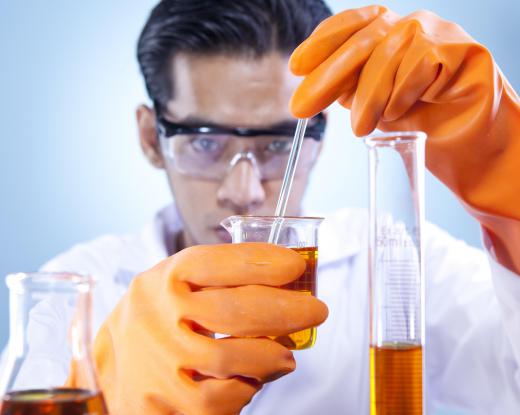What Is Chemical Kinetics?
Chemical kinetics is the study of chemical reactions and how they change based on varying conditions. The primary determination of a chemical reaction’s effects is mostly outside the substance’s actual makeup. Chemical kinetics studies these conditions to determine how and why a reaction occurs as it does. The primary applied use for the science is creating efficient, non-destructive and non-poisoning reactions for use in manufacturing, materials processing and the pharmaceutical industries. Even so, the majority of this field is pure science and research.
The base methods and responses during a chemical reaction are determined by the chemical itself. No matter what conditions are present, some materials will not react with other chemicals or with environmental factors. This forms the baseline used by chemical kinetics. Once a reaction is understood in a controlled environment, changes to the reaction can be directly attributed to changes in the conditions of the experiment.

Apart from what the initial substance actually is, the state and the concentration of the substance will play an important factor in chemical kinetics. These two factors are directly related to the condition of the initial material, rather than environment. The state of the material refers to whether it is a solid, liquid or gas. The concentration is the amount of reactant when compared to another substance or volume. This may be expressed as a ‘parts per 1,000 of X chemical’ or as a percentage of space used in the experimental area.

The concentration of material is of great importance to chemical kinetics for two reasons. First, the larger the amount of reactants, the faster the reaction will occur. This was one of the first major breakthroughs in this field and is often considered the birth point of the discipline. The second major effect is in regards to chemical interaction. If the concentration of two reactants is very low within a third non-reactive substance, then it will take a noticeable amount of time for the two reactants to actually encounter one another.
In addition to the physical properties of the material, the environment is also a big part of chemical kinetics. Environmental factors generally come down to temperature and pressure. As the temperature increases, the reactants absorb thermal energy and move faster. This allows them to interact with each other more frequently, which speeds up the reaction. Likewise, higher pressure makes more action happen in a smaller space, increasing the likelihood that the reactants encounter one another.
The last major part of chemical kinetics is the use of catalysts. These ‘third-party’ chemicals change the way in which the reaction occurs without changing the end result of the reaction. A catalyst will interact with one or more reactants and change the way they behave. This typically means they increase in energy, move faster, interact more and increase the overall reaction speed. In order to be a catalyst and not a reactant, the catalyzing material must remain unchanged during the reaction.
AS FEATURED ON:
AS FEATURED ON:












Discuss this Article
Post your comments